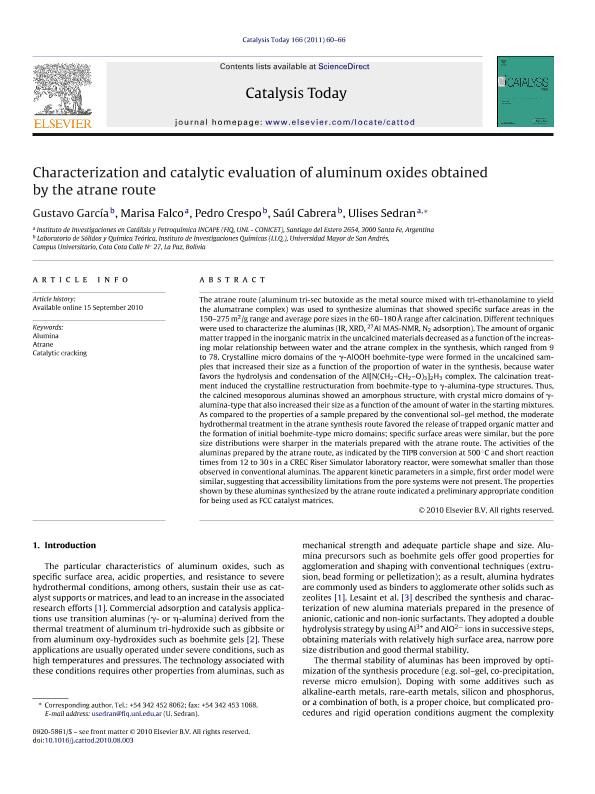Mostrar el registro sencillo del ítem
dc.contributor.author
García, Gustavo
dc.contributor.author
Falco, Marisa Guadalupe

dc.contributor.author
Crespo, Pedro
dc.contributor.author
Cabrera, Saúl
dc.contributor.author
Sedran, Ulises Anselmo

dc.date.available
2019-06-21T00:03:32Z
dc.date.issued
2011-05
dc.identifier.citation
García, Gustavo; Falco, Marisa Guadalupe; Crespo, Pedro; Cabrera, Saúl; Sedran, Ulises Anselmo; Characterization and catalytic evaluation of aluminum oxides obtained by the atrane route; Elsevier Science; Catalysis Today; 166; 1; 5-2011; 60-66
dc.identifier.issn
0920-5861
dc.identifier.uri
http://hdl.handle.net/11336/78587
dc.description.abstract
The atrane route (aluminum tri-sec butoxide as the metal source mixed with tri-ethanolamine to yield the alumatrane complex) was used to synthesize aluminas that showed specific surface areas in the 150-275 m2/g range and average pore sizes in the 60-180 range after calcination. Different techniques were used to characterize the aluminas (IR, XRD, 27Al MAS-NMR, N2 adsorption). The amount of organic matter trapped in the inorganic matrix in the uncalcined materials decreased as a function of the increasing molar relationship between water and the atrane complex in the synthesis, which ranged from 9 to 78. Crystalline micro domains of the γ-AlOOH boehmite-type were formed in the uncalcined samples that increased their size as a function of the proportion of water in the synthesis, because water favors the hydrolysis and condensation of the Al[N(CH2-CH 2-O)3]2H3 complex. The calcination treatment induced the crystalline restructuration from boehmite-type to γ-alumina-type structures. Thus, the calcined mesoporous aluminas showed an amorphous structure, with crystal micro domains of γ-alumina-type that also increased their size as a function of the amount of water in the starting mixtures. As compared to the properties of a sample prepared by the conventional sol-gel method, the moderate hydrothermal treatment in the atrane synthesis route favored the release of trapped organic matter and the formation of initial boehmite-type micro domains; specific surface areas were similar, but the pore size distributions were sharper in the materials prepared with the atrane route. The activities of the aluminas prepared by the atrane route, as indicated by the TIPB conversion at 500 °C and short reaction times from 12 to 30 s in a CREC Riser Simulator laboratory reactor, were somewhat smaller than those observed in conventional aluminas. The apparent kinetic parameters in a simple, first order model were similar, suggesting that accessibility limitations from the pore systems were not present. The properties shown by these aluminas synthesized by the atrane route indicated a preliminary appropriate condition for being used as FCC catalyst matrices.
dc.format
application/pdf
dc.language.iso
eng
dc.publisher
Elsevier Science

dc.rights
info:eu-repo/semantics/openAccess
dc.rights.uri
https://creativecommons.org/licenses/by-nc-sa/2.5/ar/
dc.subject
Alumina
dc.subject
Atrane
dc.subject
Catalytic Cracking
dc.subject.classification
Otras Ingeniería Química

dc.subject.classification
Ingeniería Química

dc.subject.classification
INGENIERÍAS Y TECNOLOGÍAS

dc.title
Characterization and catalytic evaluation of aluminum oxides obtained by the atrane route
dc.type
info:eu-repo/semantics/article
dc.type
info:ar-repo/semantics/artículo
dc.type
info:eu-repo/semantics/publishedVersion
dc.date.updated
2019-06-19T12:18:54Z
dc.journal.volume
166
dc.journal.number
1
dc.journal.pagination
60-66
dc.journal.pais
Países Bajos

dc.journal.ciudad
Amsterdam
dc.description.fil
Fil: García, Gustavo. Universidad Mayor de San Andrés; Bolivia
dc.description.fil
Fil: Falco, Marisa Guadalupe. Consejo Nacional de Investigaciones Científicas y Técnicas. Centro Científico Tecnológico Conicet - Santa Fe. Instituto de Investigaciones en Catálisis y Petroquímica "Ing. José Miguel Parera". Universidad Nacional del Litoral. Instituto de Investigaciones en Catálisis y Petroquímica "Ing. José Miguel Parera"; Argentina
dc.description.fil
Fil: Crespo, Pedro. Universidad Mayor de San Andrés; Bolivia
dc.description.fil
Fil: Cabrera, Saúl. Universidad Mayor de San Andrés; Bolivia
dc.description.fil
Fil: Sedran, Ulises Anselmo. Consejo Nacional de Investigaciones Científicas y Técnicas. Centro Científico Tecnológico Conicet - Santa Fe. Instituto de Investigaciones en Catálisis y Petroquímica "Ing. José Miguel Parera". Universidad Nacional del Litoral. Instituto de Investigaciones en Catálisis y Petroquímica "Ing. José Miguel Parera"; Argentina
dc.journal.title
Catalysis Today

dc.relation.alternativeid
info:eu-repo/semantics/altIdentifier/doi/http://dx.doi.org/10.1016/j.cattod.2010.08.003
Archivos asociados
